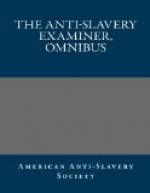[Footnote 103: There is no evidence that he knew they were negroes; or that he acted otherwise than in perfect good faith. The alleged crime was stealing a boat. The real crime, it is said, was stealing themselves and escaping in a boat. The most horrible abuses of these warrants can only be prevented by requiring proof of identity before delivery.]
Free colored men are converted into slaves not only by law, but also contrary to law. It is, of course, difficult to estimate the extent to which illegal kidnapping is carried, since a large number of cases must escape detection. In a work published by Judge Stroud, of Philadelphia, in 1827, he states, that it had been ascertained that more than thirty free colored persons, mostly children, had been kidnapped in that city within the last two years.[104]
[Footnote 104: Stroud’s Sketch of the Slave Laws, p. 94.]
10. SUBJECTION TO INSULT AND OUTRAGE.
The feeling of the community towards these people, and the contempt with which they are treated, are indicated by the following notice, lately published by the proprietors of a menagerie, in New York. “The proprietors wish it to be understood, that people of color are not permitted to enter, except when in attendance upon children and families.” For two shillings, any white scavenger would be freely admitted, and so would negroes, provided they came in a capacity that marked their dependence—their presence is offensive, only when they come as independent spectators, gratifying a laudable curiosity.
Even death, the great leveller, is not permitted to obliterate, among Christians, the distinction of caste, or to rescue the lifeless form of the colored man from the insults of his white brethren. In the porch of a Presbyterian Church, in Philadelphia, in 1837, was suspended a card, containing the form of a deed, to be given to purchasers of lots in a certain burial ground, and to enhance the value of the property, and to entice buyers, the following clause was inserted, “No person of color, nor any one who has been the subject of execution, shall be interred in said lot.”




